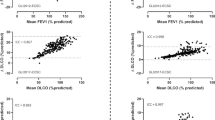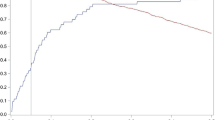Abstract
Introduction
The prevalence of pulmonary restriction increases in the elderly and detection could be challenging due to the difficulty in measuring lung volumes in older patients. The recently published Global Lung Function Initiative (GLI) equations were found to predict better restriction in middle-aged patients compared to ERS’93 norms. However, the ability of the GLI equations to detect pulmonary restriction in older patients has not been investigated.
Patients and Methods
We extracted spirometric data in patients older than 85 years from the database of our pulmonary function testing laboratory. The population with pulmonary restriction was defined as those having a total lung capacity value (TLC) below the lower limit of normal (LLN) using ERS’93 equations. We then compared the ability of the ERS’93 and GLI equations to detect this when the forced vital capacity (FVC) was below the LLN.
Results
We analyzed data from 285 patients. A true restrictive defect was found in 66 patients (23 %). Sensitivity to detect a reduced TLC was higher when calculated from the GLI than the ERS’93 equations, (70 vs 45 %). By contrast, specificity was lower (74 vs 89 %, respectively); there was no difference in the negative predictive value (89 and 84 %). Using receiver operating curves, both sets of equations performed similarly to detect spirometric restriction.
Conclusions
In conclusion, both sets of equations similarly predicted a pulmonary restriction in older subjects. The high negative predictive value of the GLI equations thus allows for static lung volume measurement to be avoided in older patients when the FCV exceeds the LLN whatever the predicted equation used.


Similar content being viewed by others
References
Christensen K, Doblhammer G, Rau R, Vaupel JW (2009) Ageing populations: the challenges ahead. Lancet 374:1196–1208. doi:10.1016/S0140-6736(09)61460-4
Scarlata S, Pedone C, Conte ME, Incalzi RA (2009) Accuracy of spirometry in diagnosing pulmonary restriction in elderly people. J Am Geriatr Soc 57:2107–2111. doi:10.1111/j.1532-5415.2009.02525.x
Stansbury R, Mannino D (2009) Diseases associated with restrictive lung function impairment. Eur Respir Monogr 43:142–149
Enright PL, Kronmal RA, Higgins MW et al (1994) Prevalence and correlates of respiratory symptoms and disease in the elderly. Cardiovascular Health Study. Chest 106:827–834
Vaz Fragoso CA, Gill TM (2012) Respiratory impairment and the aging lung: a novel paradigm for assessing pulmonary function. J Gerontol A 67:264–275. doi:10.1093/gerona/glr198
Pellegrino R, Viegi G, Brusasco V et al (2005) Interpretative strategies for lung function tests. Eur Respir J 26:948–968. doi:10.1183/09031936.05.00035205
Broughton SJ, Sylvester KP, Page CM et al (2006) Problems in the measurement of functional residual capacity. Physiol Meas 27:99–107. doi:10.1088/0967-3334/27/2/001
Aaron SD, Dales RE, Cardinal P (1999) How accurate is spirometry at predicting restrictive pulmonary impairment? Chest 115:869–873
Glady CA, Aaron SD, Lunau M et al (2003) A spirometry-based algorithm to direct lung function testing in the pulmonary function laboratory. Chest 123:1939–1946
Vandevoorde J, Verbanck S, Schuermans D et al (2008) Forced vital capacity and forced expiratory volume in six seconds as predictors of reduced total lung capacity. Eur Respir J 31:391–395. doi:10.1183/09031936.00032307
Hankinson JL, Odencrantz JR, Fedan KB (1999) Spirometric reference values from a sample of the general U.S. population. Am J Respir Crit Care Med 159:179–187. doi:10.1164/ajrccm.159.1.9712108
Cotes JE (1993) Lung function throughout life:determinants and reference values, 5th edn. Blackwell Scientific Publications, Oxford, pp 445–513
Enright P, Lehmann S (2009) Spirometry in old age: feasibility and interpretation. Eur Respir Monogr 43:25–34
Kuster SP, Kuster D, Schindler C et al (2008) Reference equations for lung function screening of healthy never-smoking adults aged 18–80 years. Eur Respir J 31:860–868. doi:10.1183/09031936.00091407
Quanjer PH, Stanojevic S, Cole TJ et al (2012) Multi-ethnic reference values for spirometry for the 3–95 year age range: the Global Lung Function 2012 equations. Eur Respir J 40:1324–1343. doi:10.1183/09031936.00080312
Quanjer PH, Brazzale DJ, Boros PW, Pretto JJ (2013) Implications of adopting the Global Lungs Initiative 2012 all-age reference equations for spirometry. Eur Respir J 42:1046–1054. doi:10.1183/09031936.00195512
Quanjer PH (1993) Standardized lung function testing, ECSC 1993 update. Eur Respir J 6:5–40
Bellia V, Pistelli R, Catalano F et al (2000) Quality control of spirometry in the elderly. The SA.R.A. study. SAlute Respiration nell’Anziano = Respiratory Health in the Elderly. Am J Respir Crit Care Med 161:1094–1100. doi:10.1164/ajrccm.161.4.9810093
Wanger J, Clausen JL, Coates A et al (2005) Standardisation of the measurement of lung volumes. Eur Respir J 26:511–522. doi:10.1183/09031936.05.00035005
Viegi G, Maio S, Simoni M et al (2009) The epidemiological link between ageing and respiratory diseases. Eur Respir Monogr 43:1–17
Bleecker ER (2004) Similarities and differences in asthma and COPD. The Dutch hypothesis. Chest 126:93S–95S. doi:10.1378/chest.126.2_suppl_1.93S, discussion 159S–161S
Conflict of interest
None.
Author information
Authors and Affiliations
Corresponding author
Rights and permissions
About this article
Cite this article
Bruel Tronchon, N., Frappé, E., Chomette Ballereau, S. et al. Prediction of Pulmonary Restriction from Forced Vital Capacity in Elderly is Similar Using GLI and ERS Equations. Lung 192, 775–779 (2014). https://doi.org/10.1007/s00408-014-9627-0
Received:
Accepted:
Published:
Issue Date:
DOI: https://doi.org/10.1007/s00408-014-9627-0




